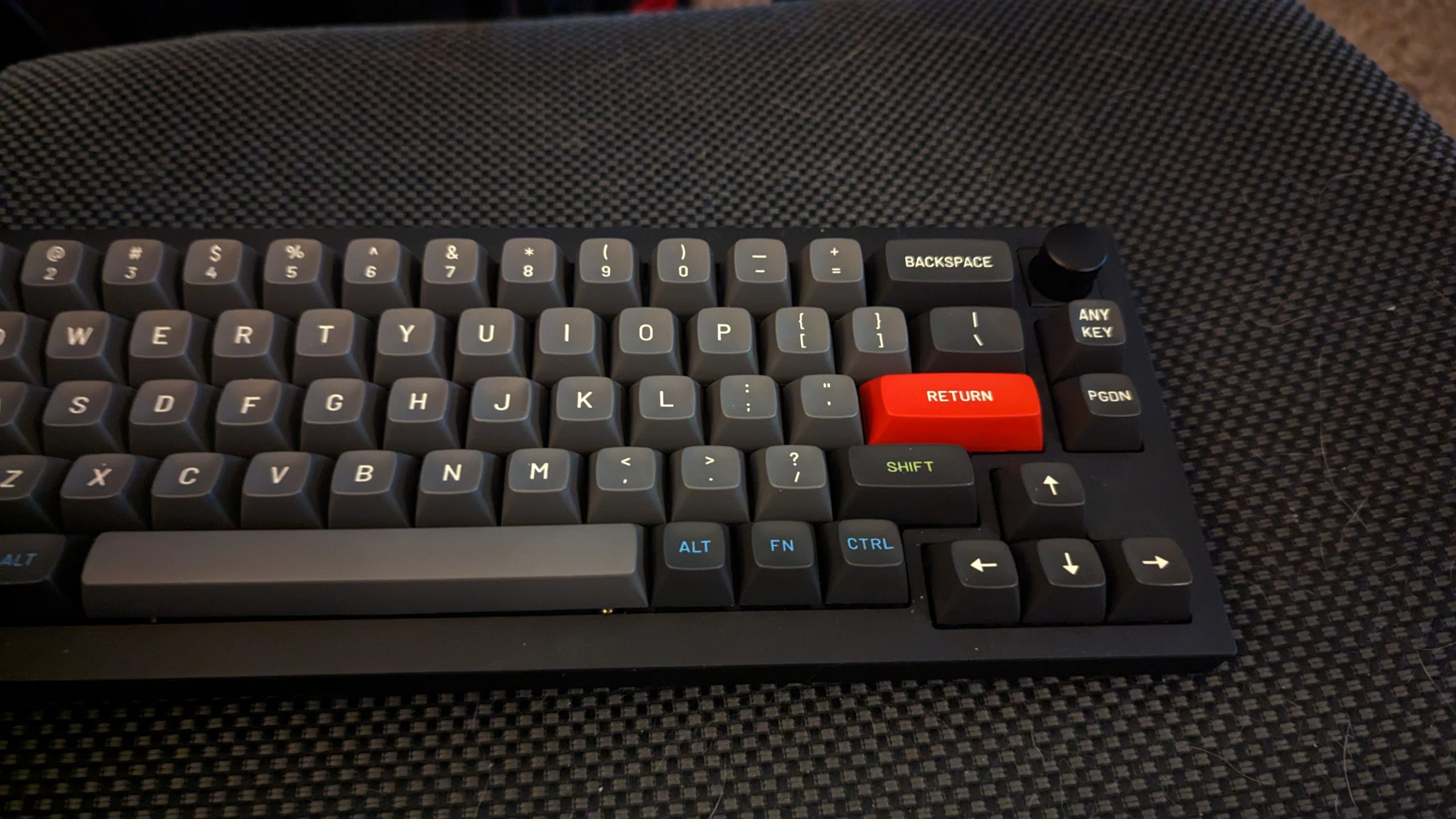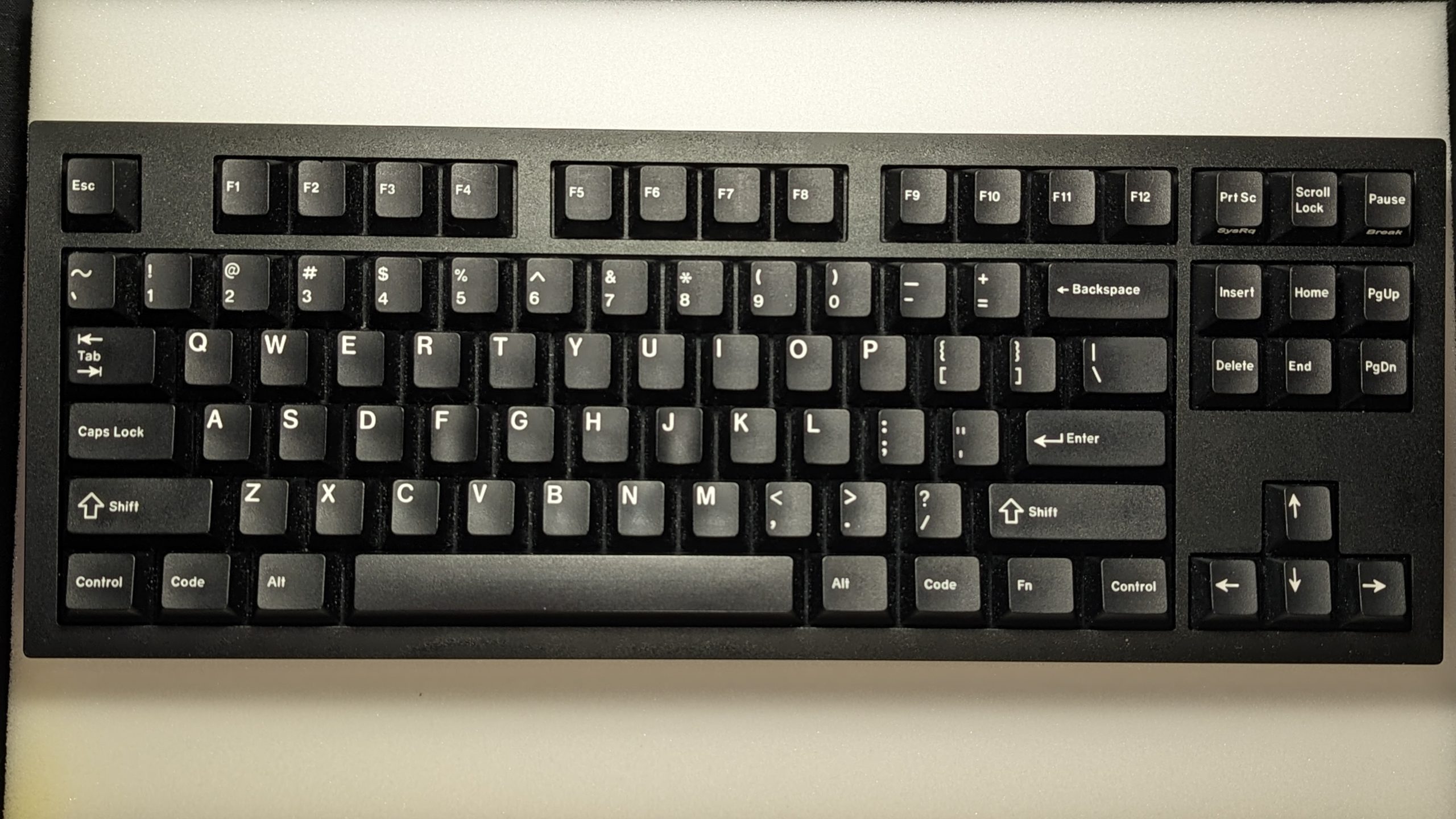Keychron Q2/Q3
Keychron is very much a one-trick pony, but at one point they were the ultimate value products and an easy recommendation to get people into the hobby. However, in the 3 and a half years of their existence, they really haven’t changed much for the better.
Design/Aesthetics
Almost all Keychron Q-series and V-series boards follow one same design: A simple box on wedge design. This on its own is fine, it’s not too simple of a design like a Tofu, but it’s not super out there like something from Matrix. Most boards present with a rather thick bezel about 10mm thick. Most of the Q-series boards are available in black, silver and navy (surface treatment uncertain), while V-series are typically either a translucent or opaque black injection molded ABS plastic case. Keychron also uses standard 8mm 3M feet which is very, very appreciated.
Most of the “condensed” layouts like 65, 75, and 1800 are exploded with the arrows and the nav column or numpad separate from the main alpha cluster. This decision is polarizing, but admittedly it’s not easy to say one is better or worse. Most layouts also come paired with the option to choose between having a knob or not, sometimes being replaced by key if opted out from the knob. Boards like the Q2 (65%) or the Q10 (75% alice) have acceptable placements for the knob, but some are kind of obnoxious like the Q3 which has it in an F13 location (which annoyingly does not get replaced with a true F13 if you opt out of the knob) or the Q5 which shifts over the media controls by .5u and ruins the clean lines of separation.
Keychron’s design is also decently tall, measuring about 21.50mm at the front height which starts to demand the use of a wrist wrest for most people, where 19mm and lower is considered very comfortable. Despite this tall height of the case, the case’s screws also peek out from the side of the case, which being brass-colored are almost obnoxious at times, where most designs, not even just custom designs, are able to properly hide these screws from plain view when in use.
Assembly
Keychron boards are not bad for disassembly. The case is screwed in with hex-keyed screws rather than Phillips which is much more welcome because Phillips screws will strip far more easily. Once the 8 screws are removed, the PCB/plate assembly will be caught on the top case for a combination of the daughterboard that is also mounted to the top case, and for Q-Pro, Q-Max, and V-Max boards the wireless antenna as well. Removal of the antenna is easy enough, however you do need to either remove the switch and keycap from the top left sockets or remove the daughterboard, kind of a pick your poison situation. Keychrons also use standoffs between the PCB and plate, so you will need to unscrew them from the back of the PCB as well.
Both the Q-series and V-Max boards are mostly gasket mounted, while regular V-series boards are tray mount.
PCB and Firmware
For being a major brand-name keyboard storefront, Keychron has honestly a great PCB. There are never any layout options, but for the sole purpose that every PCB is just a simple south-facing per-key RGB 1.6mm FR4 PCB that is pre-flashed with Via-ready QMK out of the box is nothing short of amazing. As mentioned, all PCBs lack options, meaning all the boards are fairly standard ANSI or ISO layouts with no splits or anything. Whether this is a detriment to you or not is up to you, however it’s not lost on me that basic ANSI and ISO provides the easiest keycap compatibility. This is easily the strongest case to make for Keychron boards to beginners as I simply have a hard time living without QMK and having to trust some sketchy proprietary firmware.
Typing Experience
Keychrons only vary a little bit based on the size of the layout, but by default the gasket mounting is fairly plush and offers decent bounce, while the included steel plate keeps the assembly fairly stiff. On the note of the default steel plate, it really doesn’t offer great acoustics due to being too dense and firm of a material, which makes Keychron boards usually require a bit of modding to help tame the sound and give it some life, but in the end you will almost always get a fairly thin sound that demands long poles if you want any semblence of volume.
Overview
As mentioned, Keychron is a very strong recommendation for getting somebody started with something plug-and-play. There are better options for the price such as Luminkey’s prebuilts, but if somebody is insisting on doing the research on their own and want something in a particular layout, I generally point them towards the V-Max as they are cheap, retain the gasket mount, and are plastic so they are easier to tame the sound of. I have considered getting rid of mine for the simple fact that they aren’t particularly sentimental nor are they of much value in my collection.
| Keychron Q2 |
|---|
 |
| Case Material • Aluminum |
| Plate • Steel Plate |
| Mount • Gasket Mount |
| Included Parts • Keychron Screw-In Stabilizers • Ring Keycap Puller and U Switch Puller |
| Cost • $160 |
| Release Date • 2021 |
| Keychron Q3 |
|---|
 |
| Case Material • Injection Molded ABS Plastic |
| Plate • Steel Plate |
| Mount • Gasket Mount |
| Included Parts • Keychron Screw-In Stabilizers • Ring Keycap Puller and U Switch Puller |
| Cost • $155 |
| Release Date • 2022 |
This article is not sponsored or compensated for in any way. This article falls under Fair Use and adheres to the Copyrights of the mentioned brands. Any mistakes, feedback or clarifications may be directed to askme@cheesemanfuu.com.